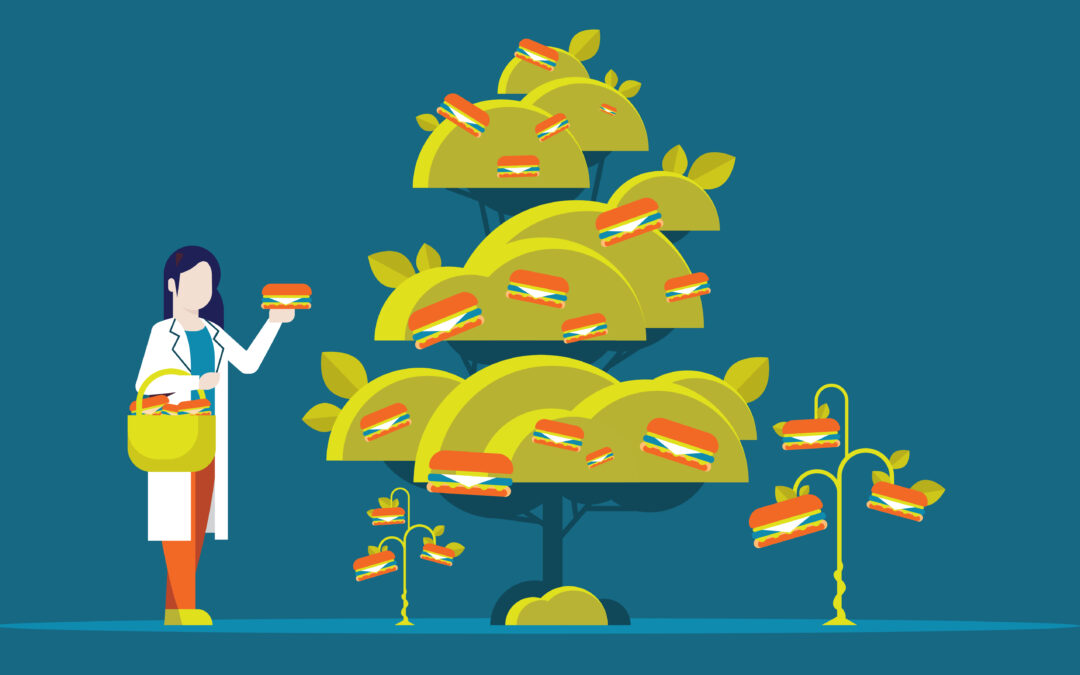From innovative cauliflower creations to the domination of veggie burgers, the future is looking green. Plant-based trends are here to stay, and with everyone and their mother embracing these alternatives, we’re seeing more players come out to take a swing. Plant-based options are even transcending the food market and into industries like cosmetics, fashion, and household cleaning products.
Plant-Based Foods You’ll See More of in 2021 and Beyond
1. Power-Packed Pea Protein
Protein powders—especially whey protein—are one of the most popular fitness supplements on the market. But while whey protein can be easily mixed into food and drinks, it often contains allergens like lactose and gluten.
Enter: Pea protein, an extract from split peas. Like whey protein, pea protein can be easily mixed into food and drink but does not contain lactose or gluten, making it easier to digest (and easier on the stomach) for those with sensitivities. While brands like KOS offer pea protein in a drinkable protein mix, other brands like Beyond Meat use pea protein as the second ingredient in their cult-favorited veggie patties. No matter how you choose to consume pea protein, the use of this ingredient is growing. Experts predict that the Global Pea Protein Market size will reach $431 Million by 2026.
2. Milk and Dairy Alternatives
For most of us, cow milk is still the gold standard for milk, cheese, yogurt, and more—but for those seeking alternatives, there’s a lot of them. Parent company Danone just announced that it is preparing its “plant-based 2.0” platform, which will work to improve the taste and texture of its oat, almond, and soy milks under the Silk brand.
Blue Diamond’s Almond Breeze brand is widely known for its almond milk, but it is no newcomer to non-dairy yogurt, either. Its Almond Breeze Almondmilk Yogurt debuted in 2019 and has since expanded to include an assortment of yogurts with fruit on the bottom, as well as a full line with crunchy toppings on top. With the global alternative dairy market projected to reach $40.6 billion in 2026, there will be even more plant-based dairy options to choose from in the years to come.
3. The Great Carb Substitute: Cauliflower
Move over, kale. Cauliflower is the power vegetable here. Cauliflower has proved itself as a stellar substitute for carbs for those following a paleo or gluten-free diet or looking to lighten up their carbo load.
Brands like Los Angeles-based Caulipower have long used cauliflower in innovative frozen pizza crusts and have since diversified their offerings with artisan-inspired, stone-fired cauliflower crusts, microwavable riced cauliflower cups, and cauliflower breaded chicken nuggets. Even Chipotle has started test marketing cauliflower rice at several locations. Frozen cauliflower products are predicted to experience prominent growth in the next five years as more innovative usages are developed.
Plant-Based Trends Venture into New Territory Outside of Food
As the plant-based market continues to go, many are left scratching their heads on what could come next after vegan burgers and new plant-based milks. Let’s look into the future of plant-based innovation and check out some of the fast-growing—and sometimes surprising—new market categories.
1. Vegan and Food Grade Cosmetics
Just a few short years ago, vegan cosmetics were seen as a niche amidst a sea of corporate giants like L’Oreal and Maybelline. But as more consumers are embracing plant-based alternatives for what they put in their bodies—they are thinking twice about what goes *on* their bodies, too. A recent study reports that the global vegan cosmetic industry is projected to reach $21.4 billion by 2027.
Bite Beauty—famously known for their edible, food-grade lipstick—uses plant-based ingredients like pomegranate, honey, citrus and coconut in their lippies without any of the silicones. Another plant-based cult favorite? RMS’ Luminizers, made with coconut and jojoba oil. Finally, Beautycounter recently announced it is saying goodbye to talc and hello to coconut oil and shea butter in its newest product line, becoming available just last month.
2. Green Cleaning Products
From environmental concerns to health issues, many consumers are opting for a greener alternative to cleaning products. In fact, the global natural household cleaners market is expected to reach $7.8 billion by 2025, according to a new report by Grand View Research, Inc.
Why the switch to all-natural and plant-based cleaners? Rising concerns over toxic chemicals including parabens, triclosan, phthalates, and ammonia, have pushed consumers away from synthetic cleaners. In addition, many natural cleaning companies are striving to be greener in more ways than the product formulations itself—many are committed to creating sustainable, eco-friendly packaging that limit waste. Take Grove Collaborative’s Essential Cleaner Concentrates Set, for example. Not only is the cleaning formula plant-based, but it is packaged in recyclable glass and designed for use with their glass spray bottle to help eliminate plastic waste from your home and the landfills.
3. Fashion-Forward Plant-Based Trends
Faux fur is the new black. Luxury brands such as Calvin Klein, Tommy Hilfiger, and Vivienne Westwood are no longer selling fur products. The reasoning behind this bold fashion statement is sustainability. Luxury brands aren’t the only fashion companies taking on this trend—several department stores have also stated they are switching to faux fur fashion so consumers can shop more consciously.
In addition to faux fur, vegan leather has become a new trend in the fashion industry, with an estimated worth of $89.6 billion by 2025. Consumer trends and focuses on sustainability have sky-rocketed the vegan leather market. Vegan leather is becoming more common in footwear, interior designing, vehicle interiors, clothing, and luxury goods. Concerns of animal cruelty are playing a vital part in the increasing demand for animal-free fashion.
While the plant-based trend tends to be seen as synonymous with food consumption, it is gradually moving into all areas of consumer behavior. As consumers focus on sustainability and environmentally conscious trends, industries are rapidly changing their philosophies on how their products are produced and who is consuming them.
To learn more about food trends dominating the market outside the plant-based market, check out 6 Food Trends of 2021. Looking to take a deeper dive into how your brand can capitalize on these trends?


